Abstract
This research proposes a generalized model, the modified second log wake law, for the time-averaged primary flow velocity which incorporates the free surface effects (dip and inflection phenomenon) and the secondary current effects. This model is applicable for the cross-sectional velocity distribution in an open channel flows and vertical and transverse velocity distributions in open channels and symmetric channel flows. The study modifies the second log wake law by removing its limitation of the sine integral wake law that requires numerical integration. A modified wake function suggests a major change in the model by making it easily computable. At first the model is proposed for velocity distribution at the channel centerline. Further, it is extended to get the velocity distribution in the whole cross-sectional plane in an artificial open channel and for velocity distribution at different sections of natural rivers. These proposed models are validated with large range of experimental data sets and river data from the Missouri, Mississippi, Rhine, Yangtze, Minjiang and Baitarani Rivers, Conveyance channels and more improved results are achieved. Besides this, these models are also fully compared with previous velocity laws and a reasonably good agreement is obtained. The 2D model is also validated for velocity distribution along the transverse direction in experimental channels and natural rivers and for both the cases results are satisfactory. The model is also validated for velocity distribution from pipe invert to obvert in pipe flows and a good agreement is achieved. Finally, the models for the depth averaged velocity along transverse direction is also proposed and it is found that proposed formulae can reproduce well the depth averaged velocity distributions.





















Similar content being viewed by others
Availability of Data and Material
All data used in this study is electronically available.
Code Availability
Not Applicable.
References
Absi R (2011) An ordinary differential equation for velocity distribution and dip-phenomenon in open channel flows. J Hydraul Res 49(1):82–89
Akalin S (2002) Water temperature effect on sand transport by size fraction in the lower Mississippi River. Ph. D. thesis, Department of Civil and Environmental Engineering, Colorado State University
Baird DC (2004) Turbulent flow and suspended sediment transport in a mobile, sand bed channel with riprap side slopes. Ph. D. thesis, Department of Civil and Environmental Engineering, University of New Mexico
Coleman J (1969) Brahmaputra river; channel process and sedimentation. Sediment Geol 3:129–239
Coleman N (1981) Velocity profiles with suspended sediment. J Hydraul Res 19(3):211–229
Coleman N (1986) Effects of suspended sediment on the open-channel velocity distribution. Water Resour Res 22(10):1377–1384
den Toonder JMJ, Nieuwstadt FTM (1997) Reynolds number effects in a turbulent pipe flow for low to moderate re. Phys Fluid 9(11):3398–3409
Durst F, Jovanovic J, Sender J (1995) LDA measurements in the near-wall region of a turbulent pipe flow. J Fluid Mech 295:305–335
EL Telbany MMM, Reynolds AJ (1980) Velocity distribution in plane turbulent channel flows. J Fluid Mech 100(1):1–29
Elata C, Ippen A (1961) The dynamics of open channel flow with suspensions of neutrally buoyant particles. Technical Report Technical Report No.45, Hydrodynamics Lab, MIT
Fredsoe J, Deigaard R (1992) Mechanics of coastal sediment transport. World Scientific, Singapore
George WK, Castillo L, Knecht P (1997) Zero pressure gradient turbulent boundary layer. Appl Mech Rev 50:689–730
Gordon L (1992) Mississippi river discharge, Technical report, San Diego. RD Instruments, San Diego
Guo J (1998) Turbulent velocity profile in clear water and sediment-laden flows. Ph. D. thesis, Colorado State University, Fort Collins, CO
Guo J (2014) Modified log-wake-law for smooth rectangular open channel flow. J Hydraul Res 52(1):121–128
Guo J (2020) Second log-wake law from pipe symmetry and its applications in symmetric and antisymmetric channel flows. J Hydraul Eng 146(1):1–6
Guo J, Julien P (2003) Modified log-wake law for turbulent flow in smooth pipes. J Hydraul Res 41(5):493–501
Guo J, Julien P (2008) Application of the modified log-wake law in open-channels. J Appl Fluid Mech 1(2):17–23
Guo J, Julien P (2008) Application of the modified log-wake law in open-channels. J Appl Fluid Mech 1(2):17–23
Guo J, Julien PY (2003) Modified log-wake law for turbulent flow in smooth pipes. J Hydraul Res 41(5):493–501
Hinze J (1975) Turbulence. McGraw-Hill, New York
Hu CH (1985) Effects of width-to-depth ratio and side wall roughness on velocity distribbution and friction factor. Ph. D. thesis, MS Thesis, Tsinghua University, Beijing, China(In Chinese)
Hultmark M (2011) Reynolds number effects on turbulent pipe flow. Ph. D. thesis, Department of Mechanical and Aerospace Engineering, Princeton University
Julien PY (2010) Erosion And Sedimentation. Cambridge University Press, New York
Julien PY (2018) River mechanics. Cambridge University Press, Cambridge, MA
Kironoto B (1993) Turbulence characteristics of uniform and non-uniform rough open-channel flow. Ph. D. thesis, Swiss Federal Institute of Technology, Lausanna, Switzerland
Knight DW (1992) Serc flood channel facility experimental data–phase a, vol 117. Technical report, School of Civil Engineering, University of Birmingham
Kundu S (2015) Theoretical study on velocity and suspension concentration in turbulent flow. Ph. D. thesis, Indian Institute of Technology Kharagpur, West Bengal, India
Kundu S (2016) Effect of lateral bed roughness variation on particle suspension in open channels. Environ Earth Sci 75(8):1–18
Kundu S, Ghoshal K (2012) An analytical model for velocity distribution and dip-phenomenon in uniform open channel flows. Int J Fluid Mech Res 39(5):381–395
Kundu S, Sen S, Mohan S, Ghoshal K (2022) Two dimensional distribution of stream-wise mean velocity in turbulent flow with effect of suspended sediment concentration. Environ Fluid Mech 22(1):138–158
Lu J, Zhou Y, Zhu Y, Xia J, Wei L (2018) Improved formulae of velocity distributions along the vertical and transverse directions in natural rivers with the sidewall effect. Environ Fluid Mech 18:1491–1508
Lu J, Zhou Y, Zhu Y, Xia J, Wei L (2018b) Improved formulae of velocity distributions along the vertical and transverse directions in natural rivers with the sidewall effect. Environ Fluid Mech 18(11)
Lyn D (1988) A similarity approach to open-channel sediment laden flows. J Fluid Mech 193(1):1–26
Miguntanna NS, Moses H, Sivakumar M, Yang SQ, Enever KJ, Riaz MZB (2020) Re.examining log law velocity profile in smooth open channel flows. Environ Fluid Mech 20:953–986
Mikkilan CB (1938) A critical discussion of turbulent flows in channels and circular tubes. In: In Proc. 5th International Congress of Applied Mechanics, Cambridge, Mass, pp 386–392
Mohan S, Kundu S, Ghoshal K, Kumar J (2021) Numerical study on two dimenisonal distribution of streamwise velocity in open channel turbulent flows with secondary current effect. Arch Mech 73(2):175–200
Mohan S, Kundu S, Ghoshal K, Kumar J (2021) Numerical stusy on two dimensional distribution of streamwise velocity in open channel turbulent flows with secondary current effect. Arch Mech 73(2):175–200
Muste M, Patel V (1997) Velocity profiles for particles and liquid in open-channel flow with suspended sediment. J Hydraul Eng 123(9):742–751
Nezu I, Rodi W (1986) Open-channel flow measurements with a laser dropper anemometer. J Hydraul Eng 112(5):335–355
Nezu I, Tominaga A, Nakagawa H (1993) Field measurements of secondary currents in straight rivers. J Hydraul Eng 119(5):598–614
Patel N, Shahi J, Guo J (2021) Applications of second log-wake law for turbulent velocity distributions in laboratory flumes and natural rivers. J Hydraul Eng 147(9):1–8
Patra KC, Kar SK, Bhattacharya AK (2004) Flow and velocity distribution in meandering compound channels. J Hydraul Eng 130(5):398–411
Prandtl L (1925) Berichtüber untersuchungen zur ausgebildeten turbulenz. Zeitschrift für Angewandte Mathematik und Mechanik 5:136–139
Reichardt H (1959) Gesetzmässigkeiten der geradlinigen turbulenten couette strömung. In: In Mitteilungen aus dem Max-Planck-Institut für Strömungsforschung,, Mitteilung Nr. 22. Gottingen, Germany: Max Planck Institute for Dynamics and Self-Organization
Sarma K, Lakshminarayana P, Rao N (1983) Velocity distribution in smooth rectangular open channels. J Hydraul Eng 109:270–289
Schultz MP, Flack KA (2013) Reynolds-number scaling of turbulent channel flow. Phys Fluids 25(2 (025104)):1–13
Tominaga A, Nezu I, Ezaki K, Nakagawa H (1989) Three-dimensional turbulent structure in straight open channel flows. J Hydraul Res 27(1):149–173
Vanoni V (1940) Experiments on the transportation of suspended sediment by water. Ph. D. thesis, California Institute of Technology, Pasadina, California
Wang X, Qian N (1989) Turbulence characteristics of sediment-laden flows. J Hydraul Eng 115(6):781–799
White FM (1991) Viscous fluid flow. McGraw-Hill, New York
Wu X, Moin P (2008) A direct numerical simulation study on the mean velocity characteristics in turbulent pipe flow. J Fluid Mech 608:81–112
Xingkui W, Ning Q (1989) Turbulence characteristics of sedimentladen flow. J Hydraul Eng 115(6):781–800
Yang S, Tan S, Lim S (2004) Velocity distribution and dip-phenomenon in smooth uniform open channel flows. J Hydraul Eng 130(12):1179–1186
You ZJ (1996) The effect of wave-induced stress on current profiles. Ocean Eng 23(7):619–628. https://doi.org/10.1016/0029-8018(95)00058-5
Yuen KWH (1989) A study of boundary shear stress, flow resistance and momentum transfer in open channels with simple and compound trapezoidal cross sections. Ph. D. thesis, University of Birmingham, Birmingham
Zagarola MV, Smits AJ (1998) Mean-flow scaling of turbulent pipe flow. J Fluid Mech 373:33–79
Zagarola MV, Smits AJ (1998) Mean-flow scaling of turbulent pipe flow. J Fluid Mech 373:33–79
Acknowledgements
Authors are very much thankful to the Associate Editor and the Reviewers for their fruitful and constructive comments which improves the manuscript.
Funding
Not Applicable
Author information
Authors and Affiliations
Contributions
Dr. Kundu originally formulated the idea of the work. Ms. Titas contributed to the preliminary concept of the study under the supervision of Dr. Kundu. Afterward, Ms.Titas prepared the initial mathematical models and Dr. Kundu modified and corrected them. Ms. Titas performed the data analysis, modeling, programming and fitting parts and prepared the initial draft of the paper. Dr. Kundu edited, revised and completed the final draft. Finally, both the authors approved this final version.
Corresponding author
Ethics declarations
Conflicts of interest
Authors declare that they do not have any conflict of interest.
Ethics Approval
Not Applicable
Consent to Participate
Not Applicable
Consent for Publication
Not Applicable
Rights and permissions
Springer Nature or its licensor (e.g. a society or other partner) holds exclusive rights to this article under a publishing agreement with the author(s) or other rightsholder(s); author self-archiving of the accepted manuscript version of this article is solely governed by the terms of such publishing agreement and applicable law.
About this article
Cite this article
Chattopadhyay, T., Kundu, S. Modified Second Log-Wake Law for Mean Velocity Distributions Along Vertical and Transverse Directions in Smooth Open-Channel Turbulent Flows With Application to Natural Rivers. Iran J Sci Technol Trans Civ Eng 47, 3095–3121 (2023). https://doi.org/10.1007/s40996-023-01081-2
Received:
Accepted:
Published:
Issue Date:
DOI: https://doi.org/10.1007/s40996-023-01081-2




